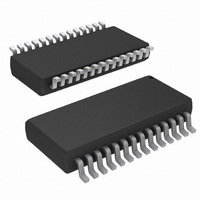ISL5961IAZ Intersil, ISL5961IAZ Datasheet - Page 10

ISL5961IAZ
Manufacturer Part Number
ISL5961IAZ
Description
CONV D/A 14-BIT 3.3V 28-TSSOP
Manufacturer
Intersil
Datasheet
1.ISL5961IAZ.pdf
(13 pages)
Specifications of ISL5961IAZ
Number Of Bits
14
Data Interface
Parallel
Number Of Converters
1
Voltage Supply Source
Analog and Digital
Power Dissipation (max)
120mW
Operating Temperature
-40°C ~ 85°C
Mounting Type
Surface Mount
Package / Case
28-TSSOP
Lead Free Status / RoHS Status
Lead free / RoHS Compliant
Settling Time
-
Power Supply
Separate digital and analog power supplies are
recommended. The allowable supply range is +2.7V to
+3.6V. The recommended supply range is +3.0 to 3.6V
(nominally +3.3V) to maintain optimum SFDR. However,
operation down to +2.7V is possible with some degradation
in SFDR. Reducing the analog output current can help the
SFDR at +2.7V. The SFDR values stated in the table of
specifications were obtained with a +3.3V supply.
Ground Planes
Separate digital and analog ground planes should be used.
All of the digital functions of the device and their
corresponding components should be located over the
digital ground plane and terminated to the digital ground
plane. The same is true for the analog components and the
analog ground plane.
Noise Reduction
To minimize power supply noise, 0.1µF capacitors should be
placed as close as possible to the converter’s power supply
pins, AV
using separate digital and analog ground planes and these
capacitors should be terminated to the digital ground for
DV
of the power supplies on the board is recommended.
Voltage Reference
The internal voltage reference of the device has a nominal
value of +1.23V with a ±40ppm/
full temperature range of the converter. It is recommended
that a 0.1µF capacitor be placed as close as possible to the
REFIO pin, connected to the analog ground. The REFLO pin
(16) selects the reference. The internal reference can be
selected if pin 16 is tied low (ground). If an external reference
is desired, then pin 16 should be tied high (the analog supply
voltage) and the external reference driven into REFIO, pin
17. The full scale output current of the converter is a function
of the voltage reference used and the value of R
should be within the 2mA to 20mA range, though operation
below 2mA is possible, with performance degradation.
If the internal reference is used, V
approximately 1.2V (pin 18). If an external reference is used,
V
I
I
If the full scale output current is set to 20mA by using the
internal voltage reference (1.2V) and a 1.91kΩ R
resistor, then the input coding to output current will resemble
the following:
OUT
OUT
FSADJ
DD
(Full Scale) = (V
(Full Scale) is:
and to the analog ground for AV
DD
will equal the external reference. The calculation for
and DV
DD
FSADJ
. Also, the layout should be designed
/R
10
SET)
o
C drift coefficient over the
FSADJ
X 32.
DD
. Additional filtering
will equal
SET
SET
. I
OUT
ISL5961
Analog Output
IOUTA and IOUTB are complementary current outputs. The
sum of the two currents is always equal to the full scale
output current minus one LSB. If single ended use is
desired, a load resistor can be used to convert the output
current to a voltage. It is recommended that the unused
output be either grounded or equally terminated. The voltage
developed at the output must not violate the output voltage
compliance range of -1.0V to 1.25V. R
loading each current output) should be chosen so that the
desired output voltage is produced in conjunction with the
output full scale current. If a known line impedance is to be
driven, then the output load resistor should be chosen to
match this impedance. The output voltage equation is:
V
The most effective method for reducing the power
consumption is to reduce the analog output current, which
dominates the supply current. The maximum recommended
output current is 20mA.
Differential Output
IOUTA and IOUTB can be used in a differential-to-single-
ended arrangement to achieve better harmonic rejection.
With R
will provide a 500mV (-2.5dBm) signal at the output of the
transformer if the full scale output current of the DAC is set to
20mA (used for the electrical specifications table). Values of
R
performance curves to increase the output power and the
dynamic range. The center tap in Figure 13 must be
grounded.
In the circuit in Figure 14, the user is left with the option to
ground or float the center tap. The DC voltage that will exist
at either IOUTA or IOUTB if the center tap is floating is
IOUT
transformer. If the center tap is grounded, the DC voltage is
0V. Recommended values for the circuit in Figure 14 are
R
performance of Figure 13 and Figure 14 is basically the
same, however leaving the center tap of Figure 14 floating
allows the circuit to find a more balanced virtual ground,
theoretically improving the even order harmonic rejection,
but likely reducing the signal swing available due to the
output voltage compliance range limitations.
INPUT CODE (D13-D0)
OUT
DIFF
A
=R
1111 11111 11111
1000 00000 00000
0000 00000 00000
TABLE 1. INPUT CODING vs OUTPUT CURRENT WITH
DC
B
= 100Ω and R
= I
DIFF
=50Ω, R
OUT
x (R
INTERNAL REFERENCE AND RSET=1.91KΩ
= 50Ω and R
A
X R
//R
DIFF
B
OUT
) V because R
=100Ω, assuming R
LOAD
.
LOAD
=50Ω were used for the typical
IOUTA (mA)
=50Ω, the circuit in Figure 13
20
10
0
DIFF
OUT
is DC shorted by the
LOAD
(the impedance
IOUTB (mA)
=50Ω. The
10
20
0















